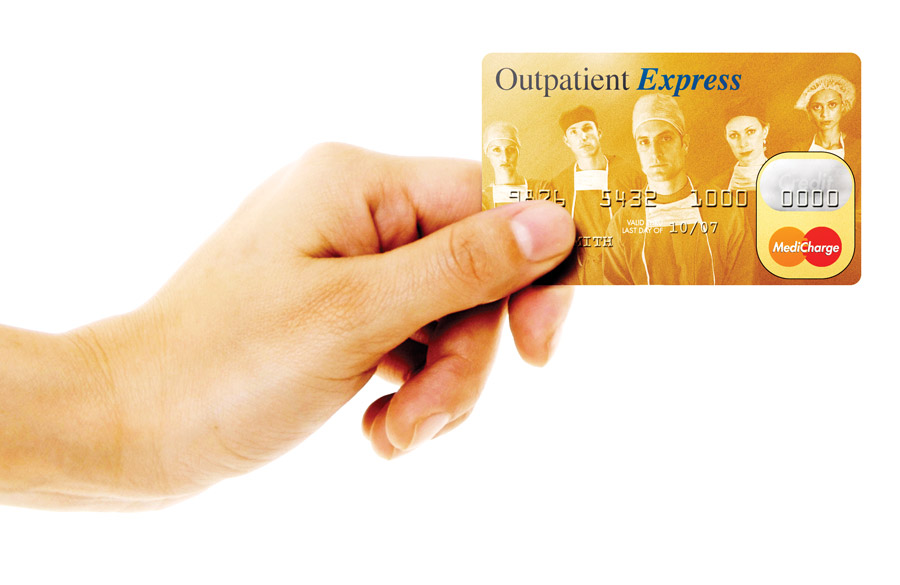Six Surface Disinfection Concepts
The puzzle of superior surface disinfection is never solved....
This website uses cookies. to enhance your browsing experience, serve personalized ads or content, and analyze our traffic. By clicking “Accept & Close”, you consent to our use of cookies. Read our Privacy Policy to learn more.
By: Dan O'Connor
Published: 4/15/2019

As patients' out-of-pocket healthcare costs continue to rise, more and more are taking out loans or lines of credit through their surgical facilities to cover their copays and deductibles. At the Gadsden (Ala.) Surgery Center, about 1 in 4 patients applies online or over the phone for a healthcare credit card with deferred (and hopefully no) interest to finance their insurance fees. Most are same-day approved — even those with low or poor credit scores — in a matter of minutes, happily turning their $1,000 deductible into 12 convenient, low monthly payments.
The surgery center is happy, too. Helping patients finance their surgery is a big win for the facility: no cancellations, no accounts receivables and "we get our money up front with no further statements," says Harriet Willoughby, RN, BSN, the CEO (and chief loan officer) of Gadsden Surgery Center, "and we don't have to set up payment plans for our patients, which can drag on and on."
Healthcare providers have traditionally relied on insurance to pay for most of a procedure's costs. But with some predicting that patients will soon supplant insurers as the No. 1 payer — by some estimates, self-pay is close to 30% of hospital and health system payments today — the ability to lock in the patient-pay portion of your facility's revenue is critical. Plus, you're throwing patients a lifeline.
"Patient deductibles have gotten so high that many can't afford it," says Ms. Willoughby. "This just buys them some time to be able to pay it off."
A patient scheduled for surgery on Monday can apply for a medical credit card the Friday before and receive a credit number — patients can use the plastic card that will arrive in the mail later at the dentist or veterinarian, says Ms. Willoughby — that the surgery center can call into the credit card company in order to receive payment.
"It gives patients another way to release some of the burden to cash out or take a loan out," says Ms. Willoughby. "Most people can pay off something in 6 months or a year, but it hurts us tremendously if we drag it out."
Still, though, "stress to patients to make their payments timely. Patients don't always pay on time and then they do get high-interest charges," says Monica Ziegler, MSN, the administrator of the Manhattan Surgery Center in New York City.

Each week, about 3 of our patients use healthcare credit, mostly middle-aged and younger orthopedic patients and self-pay patients. A few tips for success:
But keep in mind, the longer the payment term, the higher the transaction fee with which you'll be charged. For example, one healthcare lender charges a 2.9% fee for a 6-month plan and a 7.9% fee for a 12-month plan (minimum balance $1,250). We limit the terms we offer patients to 6 months.
You can also offer patients a fixed-rate extended-payment plan over 24, 36, 48 or 60 months. Interest is built into the loan payment, which stays the same each month. A leading creditor's interest rate on a 60-month plan is 16.9%.
Some lenders approve all patients and even let them choose their own terms so they can customize a plan that fits their budget, but others require a certain credit score to grant approval. This leaves the patients that most need to finance their out-of-pocket costs out in the cold.
A key to success with healthcare credit is letting patients know beforehand that they need it so that they can apply before they show up for surgery. Most consumers are unaware of their copays or deductibles — or when their deductibles reset. It behooves you to let patients know what their financial responsibility is well in advance of their scheduled surgery.
"When the physician's office schedules the patient with us, our insurance person looks his insurance up online and then calls patients to let them know their deductible or copay," says Ms. Willoughby. "We do this as quickly as we can so that patients can make arrangements if need be. We stand a better chance the earlier we reach patients with their amounts." Barbara Getlan, RN, BSN, the nurse administrator at the Dulaney Eye Institute in Towson, Md., agrees. "When we make pre-op financial responsibility calls, many times we introduce [healthcare credit] to the patients as a way for them to be able to cover fees they otherwise would not be able to," says Ms. Getlan. "With high-deductible insurance plans and copays, many patients use it."

Each member of your business office staff should understand patients' insurance plans better than the patients themselves. Upload the terms of the contracts into your billing software to ensure you generate the correct payment rates when you input CPT codes.
Train your staff on the calculations used to determine payment rates and patients' co-pays so that you can have an informed discussion about the benefits when you contact patients a week before surgery to inform them of their financial responsibilities. Be transparent. Let patients know that if you submit a bill for $14,000 to the insurer, the insurer will pay you, let's say, $4,000. Of that $4,000, the patient might be responsible for a $2,000 deductible. Their plan might cover 80% of the remaining $2,000, so they'd owe an additional $400.
Ms. Willoughby shudders to think what her facility's finances would look like if patients couldn't finance their portions of the bill. "They wouldn't look so good," she says. "It would definitely increase our billing time and greatly delay us receiving our money. It would also create a paper trail where we have to generate bills for them and then send collection letters."
Good luck with those collection letters. You'll need it. The percentage of collections on patients with balances greater than $5,000 is said to be 4 times lower than collections on low-deductible plan patients.
Keep in mind that not all financing is free to you. While some lenders pay facilities 100% payment up front, others will charge you a transaction or a provider fee that can be as high as 15%. Generally, the longer the patient payment term, the higher the transaction fee with which they'll charge you. To give you an idea, one lender charges a 2.9% fee for a 6-month plan and a 7.9% fee for a 12-month plan.
"Watch which plans you offer to patients or the center will get the 13% reduction in payment," says Ms. Ziegler. "We only offer 3 of the plans available to minimize the charge to us."
Experts say you should search for a plan with no hidden fees or pre-payment penalties, a simple application process and no hard credit inquiries. Most patients will finance copays and deductibles, but others will finance non-covered services such as premium intraocular lenses or uncovered elective surgery, such as cosmetic, bariatric and infertility procedures. For many of these self-pay patients, one of the biggest worries is "How am I going to pay for this?" Patient financing plans may help your patients clear this hurdle — and ensure that you get paid fast and in full.
"We are able to offer interest-free financing to those that qualify," says Rita Williams, administrator of the Surgery Center of Lawton (Okla.). OSM
A key to success with healthcare credit is letting patients know beforehand that they need it so that they can apply before they show up for surgery. Most consumers are unaware of their copays or deductibles — or when their deductibles reset. It behooves you to let patients know what their financial responsibility is well in advance of their scheduled surgery.
"When the physician's office schedules the patient with us, our insurance person looks his insurance up online and then calls patients to let them know their deductible or copay," says Ms. Willoughby. "We do this as quickly as we can so that patients can make arrangements if need be. We stand a better chance the earlier we reach patients with their amounts." Barbara Getlan, RN, BSN, the nurse administrator at the Dulaney Eye Institute in Towson, Md., agrees. "When we make pre-op financial responsibility calls, many times we introduce [healthcare credit] to the patients as a way for them to be able to cover fees they otherwise would not be able to," says Ms. Getlan. "With high-deductible insurance plans and copays, many patients use it."

Each member of your business office staff should understand patients' insurance plans better than the patients themselves. Upload the terms of the contracts into your billing software to ensure you generate the correct payment rates when you input CPT codes.
Train your staff on the calculations used to determine payment rates and patients' co-pays so that you can have an informed discussion about the benefits when you contact patients a week before surgery to inform them of their financial responsibilities. Be transparent. Let patients know that if you submit a bill for $14,000 to the insurer, the insurer will pay you, let's say, $4,000. Of that $4,000, the patient might be responsible for a $2,000 deductible. Their plan might cover 80% of the remaining $2,000, so they'd owe an additional $400.
Ms. Willoughby shudders to think what her facility's finances would look like if patients couldn't finance their portions of the bill. "They wouldn't look so good," she says. "It would definitely increase our billing time and greatly delay us receiving our money. It would also create a paper trail where we have to generate bills for them and then send collection letters."
Good luck with those collection letters. You'll need it. The percentage of collections on patients with balances greater than $5,000 is said to be 4 times lower than collections on low-deductible plan patients.
The puzzle of superior surface disinfection is never solved....
Boston Children’s Hospital is renowned for its exemplary care on many fronts, including surgery....
Manual cleaning done properly is effective for eradicating microorganisms....